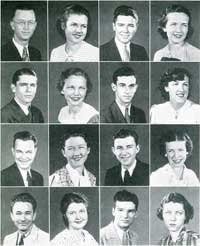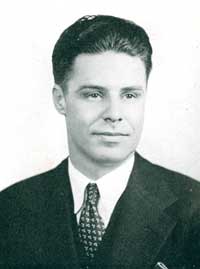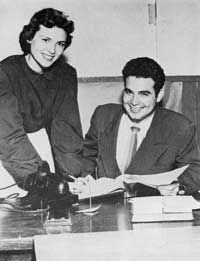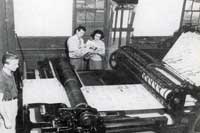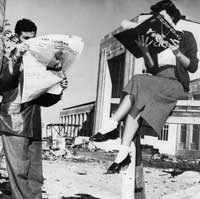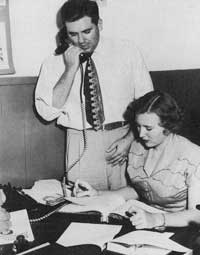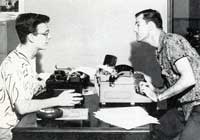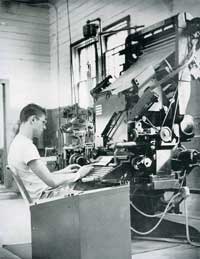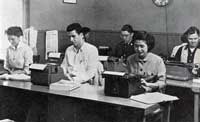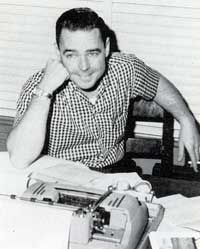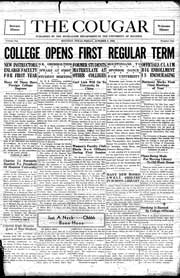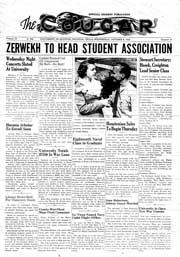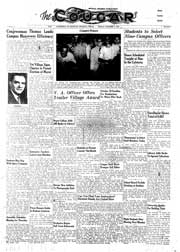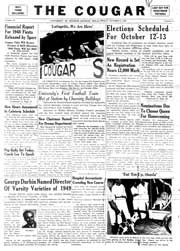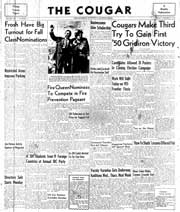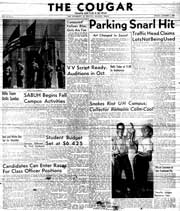1934–1959
A tradition is born
— but can we keep it?
The Cougar has a somewhat complicated history when it comes to its origins.
It was on April 6, 1928, that a newspaper called The Cougar was first published as the official newspaper of the Houston Junior College. Its first volume contained only two issues: the second was published April 30. The paper was organized in part by “honorary adviser” F.M. Black, who was dean of the community college, which was then located at San Jacinto High School. The paper was produced sporadically over the course of six years, encompassing seven volumes. At its peak, it produced 12 issues in one year. The staff worked for journalism credit.
But once the University of Houston was formed in 1934, the paper reset its clock and its volume number reverted to No. 1. It was then, on Oct. 5, 1934, the Cougar heralded the opening of the school’s first regular term with a large banner headline.
The next week, the paper reported it would be publishing every Friday night. A front-page headline read, “Student body urged to co-operate with staff.” Several hundred copies were to be distributed to the dean’s office. In its staff editorial on Page 2, the editors wrote: “It is with pardonable pride that we look upon the conversion of The Cougar from an occasional paper to the status of a weekly newspaper.” They also urged the student body to send in news items to get the 19,000 words needed to fill the small paper.
The staff then was made up of an editor in chief – the first was William Donald Bell – a managing editor, a humor editor, a feature editor and about two dozen contributing writers.
In successive editorials, the paper pushed for greater school spirit, attention to the rules (they often chastised women for not following a rule against smoking near the entrance of the building) and improved student life, such as calling for a student yearbook.
Campus crime made its first headline on Feb. 1, 1935 after two men ordered a student into her car, where she was forced to drive them around downtown and then give up the car. Citing a buildup of thefts and burglaries, The Cougar called for the creation of a campus police force or securing at least one full-time officer on campus.
In 1935, The Cougar joined the Associated Collegiate Press and began including its Collegiate Digest, a photo magazine insert, regularly. Ad revenues began to climb, fueled mostly by cigarette and pipe tobacco products.
In 1937, as the UH campus was in its infancy, The Cougar announced it would be seeking editors in chief by way of a popular vote. In the May 28 issue that year, Jane Rogers won the vote and became editor in chief. More than 200 ballots were cast. Rogers brought a more serious tone to the paper that resulted in more news reporting, which was a boon to the paper then, when news was plentiful. On her watch, the Cullen family announced its $260,000 gift to jump-start the University’s building plan. In fact, the paper was being printed when she received a phone call from a source telling her the news. For a moment, the small weekly felt like a metropolitan daily. Rogers and a handful of editors had the press run suspended as they recomposed the paper to break the biggest story of The Cougar’s history.
In 1939, The Cougar moved into its first formal office, located in the tower of the recently constructed Roy Gustav Cullen Building. From there, the paper boasted a circulation of 2,200 – one for every enrolled student — that was distributed on campus on Fridays and to several downtown businesses on Saturdays. Before, the staff had published mostly four-page editions. In 1939, more papers reached the eight-page mark.
In its first tiff with student government, the paper blasted the Student Council with a big headline: “Council attacks Cougar,” after it voted to disclose election results before releasing them to The Cougar. Later, the paper worked out an agreement to keep the paper’s exclusive rights to publish election results, and the council to formed a public relations office to prevent further conflicts.
In 1940, two editors, Alice David and Wellington Abbey, resigned after an editorial calling on parents to stay at home so that students wouldn’t go to honky tonk was censored. In place of the editorial, the paper ran a piece rejoicing the arrival of spring. Later, the paper reprinted a Houston Post editorial questioning the role of the administration in deciding what goes into a university newspaper.
According to a 1943 Cougar financial report, the paper relied largely on advertising revenue to pay the salaries of its student editor in chief and business manager and to cover the $50 to $60 printing cost per issue. The administration provided a $400 annual subsidy, of which The Cougar reportedly used about $150 each year.
Calls for more news space were met with a dose of realism from the editorial board, which wrote on May 24, 1941 that a daily newspaper on the level of the Daily Texan would not be possible without a blanket tax on all students.
While the campus provided more than enough news, the paper was consistently worried by the building European war and the question of neutrality. The Cougar’s first poll of the student body asked if students supported FDR’s seeking a third term. More than 70 percent of 186 respondents did not.
Despite the light-hearted campus gossip column “Off the Beam,” by Jack Valenti, perhaps The Cougar’s most prominent alumnus, the 1940s brought a dramatic change in the business of the University.
On Dec. 19, 1941, The Cougar responded to the Pearl Harbor attacks and the call to war with a “Defense Issue” that brandished the paper’s first use of color — a large red “V” with the Morse code equivalent, laid over the copy, which brought news of new defense classes.
“Keep your eyes open and your mouths shut,” administrators advised students in one front page story. The University organized several defense and first aid courses and proposed organizing a defense guard to oversee regular air raid and blackout drills. In subsequent issues, the paper brought news of students donating to a blood plasma bank and joining the service. Dean Dupre urged students to stay in school unless drafted, saying that the war would call for leaders “that only colleges can provide.”
The war effort brought new resources to UH. A $360,370 Works Progress Adminstration grant paved the way for the creation of a recreation building, an outdoor theater and swimming pool. Meanwhile, the Student Council approved a blanket tax on all students to pump new funds into The Cougar, the Houstonian yearbook, student activities and an intramural athletics field.
About 160 Navy servicemen arrived at UH in March 1942 after the University was named one of the country’s limited number of Navy radio schools. Later, UH was also named a War Information Center, requiring it to provide information on war training, historical information and other materials to regional offices.
Even as rationing kept business growth stunted and advertising revenue low, The Cougar kept publishing and even broke new ground with its first summer issue on June 19, 1942. In the fall, it was back into its groove, decrying that “school spirit is dying” and calling for the creation of a UH band, and later, a fight song. The paper also created a UH Spirit Award, which went to the most spirited campus organization, and sponsored Varsity Varieties, a show used to raise funds for journalism scholarships.
As an increasing number of students and ex-students were called up into the armed forces, The Cougar committed to sending out the paper to 500 servicemen from UH. To pay for this, the paper began a campaign to get 500 matching subscribers to pay 50 cents apiece to help pay for the shipment of the paper. With the help of letters from men in uniform, The Cougar got enough subscribers to effectively publish worldwide.
On April 2, 1943, The Cougar editorial board thanked its readers for supporting their servicemen-subscription program. An editorial cartoon ran with it, showing a pair of soldiers reading a paper that said, “Wars may come and go, but the Cougar goes on forever.”
The Cougar was soon asking the administration to build a memorial for the ex-students killed in the war and for all ex-students who served.
Big money, bigger parties
On the eve of victory in the Pacific, The Cougar was fighting its own battles against the would-be rivals, Rice. In a Feb. 16, 1945, editorial, The Cougar rebuffed the Rice Thresher newspaper for an editorial that called UH “a hopeless inadequate grade school located on the other side of the intellectual tracks.” In later editorials, The Cougar criticized students for having an “inferiority complex” and staunchly supported the move to separate UH from the Houston Independent School District.
Steadily increasing advertising revenue led the staff to start toying with the idea of having a large, broadsheet-size newspaper in 1947. It published several issues in this format, but decided to revert back to the five-column tabloid for its compact and convenient size. Classified advertising began to appear occasionally at this time as well, usually help wanted ads.
The biggest issue facing the campus in 1947 was whether the University should be renamed to honor their benefactor, Hugh Roy Cullen, who committed a $160 million endowment that year. The Chamber of Commerce proposed changing the name to Cullen University, but opinions were largely split down the middle. The Cougar sought a middle ground: the Cullen University of Houston. In the end, Cullen refused to have his name put on the University itself.
In October 1947, the Cougar took on a twice-weekly publication schedule, with papers hitting the stands every Tuesday and Friday, further reflecting the paper’s maturity as the campus population boomed: Enrollment had nearly tripled in as many years. By 1947, there were well more than 10,000 students. More than 300 trailers were shipped to the campus to house thousands of veterans, for whom there were no residence halls, nor was there any barrack space left at Ellington Field.
The 1950s brought more growth for the newspaper. It moved into a bigger quarters in 1955 in the new Communication Arts Building, which provided The Cougar with its first office designed for newspaper work, complete with a 12-typewriter “city room,” two separate offices for management and a fully equipped darkroom.
By this time, the Student Publications Committee had formed, composed of the editors in chief of The Cougar and Houstonian, the Harvest literary magazine editor, a Student Government-appointed representative and several faculty members. The committee was charged mainly with selecting the editor of The Cougar and the assistant editor for the Houstonian.
If there was any one dominant story throughout the 1950s, it was Frontier Fiesta. Nearly every issue of the paper contained at least one article tracking the progress of the event and its associated contests and plans.
When Frontier Fiesta was threatened with being shut down by the administration over concerns about effects on students studies, The Cougar responded with a moderate proposal of placing regulations on Fiesta, such as setting caps on how much time and money can be spent on the “Greatest Show on Earth.”
In 1957, circulation was 6,800, and the paper was regularly printed in the broadsheet format throughout the 1950s, though it switched back to a weekly press run. The staff grew to support six full time editors, managers and salesmen and about 40 reporters.
In the spring of 1957, the Student Government funded a pet project, producing a daily Bulletin to circulate news on campus more rapidly than The Cougar. The paper supported the project, saying a daily news outlet will “unify the campus.”
An editorial board that continually had chided the school for a lack of school spirit changed its tune in a 1958 editorial that put apathy in perspective, pointing out that school activities must compete with family responsibilities, work schedules and “the thousand and one diversions offered an intelligent student body in a growing metropolis.” The editorial ended thus: “Apathy is a minor item.”
In 1958, a new adviser took over and the paper went back, again, to the student-friendly tabloid format. But this time, the paper was considerably larger in the number of pages, with 12-page papers appearing every week. A crossword, sponsored by Kool Cigarettes, began appearing regularly in The Cougar.
